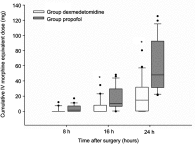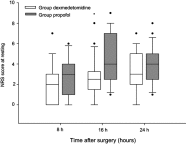Postoperative pain control after the use of dexmedetomidine and propofol to sedate patients undergoing ankle surgery under spinal anesthesia: a randomized controlled trial
- PMID: 31190958
- PMCID: PMC6526030
- DOI: 10.2147/JPR.S195745
Postoperative pain control after the use of dexmedetomidine and propofol to sedate patients undergoing ankle surgery under spinal anesthesia: a randomized controlled trial
Abstract
Background: Dexmedetomidine is widely used for conscious sedation in patients undergoing lower-extremity surgery under regional anesthesia. We evaluated the postoperative analgesic effects of intravenous dexmedetomidine given during ankle surgery under spinal anesthesia. Methods: Forty-three participants underwent repair of lateral angle ligaments under spinal anesthesia. For sedation during surgery, participants were allocated to a dexmedetomidine group (n=22) that received a loading dose of 1 mcg.kg-1 over 10 min, followed by a maintenance dose of 0.2-0.7 μg.kg-1.h-1; and a propofol group (n=21) that received an effective site concentration of 0.5-2.0 μg.mL-1 via target-controlled infusion. The primary outcome was the postoperative, cumulative, intravenous (IV) morphine equivalent dose delivered via IV patient-controlled anesthesia (PCA) and rescue analgesic consumption in the first 24 h after surgery. We recorded sensory and motor block durations. Results: The postoperative IV morphine equivalent dose was 14.5 mg (0.75-31.75 mg) in the dexmedetomidine group compared to 48.0 mg (31.5-92.5 mg) in the propofol group (median difference, 33.2 mg; 95% confidence interval, 21.0-54.8 mg; P<0.001). The time to the first complaint of surgical site pain was significantly prolonged in the dexmedetomidine group (P<0.001), but the duration of motor block was comparable between the two groups (P=0.55). Conclusion: IV dexmedetomidine given as a sedative during ankle surgery under spinal anesthesia reduced postoperative opioid consumption in the first 24 h. Thus, intraoperative dexmedetomidine is a versatile sedative adjunct. Level of evidence: Level I, prospective randomized trial.
Keywords: ankle surgery; dexmedetomidine; postoperative analgesia; spinal anesthesia.
Conflict of interest statement
The authors report no conflict of interest in this work.
Figures




Similar articles
-
Effect of Intraoperative Sedation with Dexmedetomidine Versus Propofol on Acute Postoperative Pain Following Major Foot Surgery under Popliteal Sciatic Nerve Block: A Randomized Controlled Trial.J Clin Med. 2020 Feb 28;9(3):654. doi: 10.3390/jcm9030654. J Clin Med. 2020. PMID: 32121242 Free PMC article.
-
Dexmedetomidine during total knee arthroplasty performed under spinal anesthesia decreases opioid use: a randomized-controlled trial.Can J Anaesth. 2016 May;63(5):569-76. doi: 10.1007/s12630-016-0597-y. Epub 2016 Jan 29. Can J Anaesth. 2016. PMID: 26830642 Clinical Trial.
-
[Effect of dexmedetomidine infusion on postoperative recovery for patients undergoing major spinal surgery during propofol anesthesia].Beijing Da Xue Xue Bao Yi Xue Ban. 2016 Jun 18;48(3):529-33. Beijing Da Xue Xue Bao Yi Xue Ban. 2016. PMID: 27318919 Clinical Trial. Chinese.
-
Effectiveness of ondansetron as an adjunct to lidocaine intravenous regional anesthesia on tourniquet pain and postoperative pain in patients undergoing elective hand surgery: a systematic review protocol.JBI Database System Rev Implement Rep. 2015 Jan;13(1):27-38. doi: 10.11124/jbisrir-2015-1768. JBI Database System Rev Implement Rep. 2015. PMID: 26447005
-
Practical Considerations for Dexmedetomidine Sedation in Adult Cataract Surgery Under Local/Regional Anesthesia: A Narrative Review.Anesth Pain Med. 2021 Sep 18;11(4):e118271. doi: 10.5812/aapm.118271. eCollection 2021 Aug. Anesth Pain Med. 2021. PMID: 34692445 Free PMC article. Review.
Cited by
-
Perioperative Hypotension in Patients Undergoing Orthopedic Upper Extremity Surgery with Dexmedetomidine Sedation: A Retrospective Study.J Pers Med. 2023 Nov 28;13(12):1658. doi: 10.3390/jpm13121658. J Pers Med. 2023. PMID: 38138885 Free PMC article.
-
Efficacy of perioperative dexmedetomidine in postoperative pain and neurocognitive functions in orthopedic surgery: a systematic review and meta-analysis with trial sequential analysis of randomized controlled trials.Int J Surg. 2025 May 1;111(5):3525-3542. doi: 10.1097/JS9.0000000000002315. Int J Surg. 2025. PMID: 40042401 Free PMC article.
-
The efficacy of intramuscular ephedrine in preventing hemodynamic perturbations in patients with spinal anesthesia and dexmedetomidine sedation.Int J Med Sci. 2020 Aug 25;17(15):2285-2291. doi: 10.7150/ijms.48772. eCollection 2020. Int J Med Sci. 2020. PMID: 32922193 Free PMC article. Clinical Trial.
-
Dexmedetomidine vs other sedatives in critically ill mechanically ventilated adults: a systematic review and meta-analysis of randomized trials.Intensive Care Med. 2022 Jul;48(7):811-840. doi: 10.1007/s00134-022-06712-2. Epub 2022 Jun 1. Intensive Care Med. 2022. PMID: 35648198
-
Effect of Intraoperative Sedation with Dexmedetomidine Versus Propofol on Acute Postoperative Pain Following Major Foot Surgery under Popliteal Sciatic Nerve Block: A Randomized Controlled Trial.J Clin Med. 2020 Feb 28;9(3):654. doi: 10.3390/jcm9030654. J Clin Med. 2020. PMID: 32121242 Free PMC article.
References
-
- Hall JE, Uhrich TD, Barney JA, Arain SR, Ebert TJ. Sedative, amnestic, and analgesic properties of small-dose dexmedetomidine infusions. Anesth Analg. 2000;90(3):699–705. - PubMed
-
- Abdallah FW, Dwyer T, Chan VW, et al. IV and perineural dexmedetomidine similarly prolong the duration of analgesia after interscalene brachial plexus block: a randomized, three-arm, triple-masked, placebo-controlled trial. Anesthesiology. 2016;124(3):683–695. doi:10.1097/aln.0000000000000983 - DOI - PubMed
LinkOut - more resources
Full Text Sources

